Kingston DataTraveler Max UFD Review: NVMe Performance in a USB Thumb Drive
by Ganesh T S on September 30, 2021 10:00 AM ESTPerformance Benchmarks
Benchmarks such as ATTO and CrystalDiskMark help provide a quick look at the performance of the direct-attached storage device. The results translate to the instantaneous performance numbers that consumers can expect for specific workloads, but do not account for changes in behavior when the unit is subject to long-term conditioning and/or thermal throttling. Yet another use of these synthetic benchmarks is the ability to gather information regarding support for specific storage device features that affect performance.
Synthetic Benchmark - ATTO
Kingston claims read and write speeds of 1000 MBps and 900 MBps respectively, and these are backed up by the ATTO benchmarks provided below - in fact, the numbers are actually higher than the claimed ones. ATTO benchmarking is restricted to a single configuration in terms of queue depth, and is only representative of a small sub-set of real-world workloads. It does allow the visualization of change in transfer rates as the I/O size changes, with optimal performance being reached around 512 KB for a queue depth of 4. The performance is slightly behind the bridge solutions in terms of raw numbers.
| ATTO Benchmarks | |
| TOP: | BOTTOM: |
 |
|
 |
|
Synthetic Benchmark - CrystalDiskMark
CrystalDiskMark. for example, uses four different access traces for reads and writes over a configurable region size. Two of the traces are sequential accesses, while two are 4K random accesses. Internally, CrystalDiskMark uses the Microsoft DiskSpd storage testing tool. The 'Seq128K Q32T1' sequential traces use 128K block size with a queue depth of 32 from a single thread, while the '4K Q32T16' one does random 4K accesses with the same queue configuration, but from multiple threads. The 'Seq1M' traces use a 1MiB block size. The plain 'Rnd4K' one uses only a single queue and single thread . Comparing the '4K Q32T16' and '4K Q1T1' numbers can quickly tell us whether the storage device supports NCQ (native command queuing) / UASP (USB-attached SCSI protocol). If the numbers for the two access traces are in the same ballpark, NCQ / UASP is not supported. This assumes that the host port / drivers on the PC support UASP.
| CrystalDiskMark Benchmarks | |
| TOP: | BOTTOM: |
 |
|
 |
|
The sequential workloads' numbers are essentially the same for both the UFD and bridge solutions. However, the benefits of a real SSD controller are evident in the high queue-depth random access performance, where the DT Max's performance is cut in half compared to the ASMedia bridge solution.
AnandTech DAS Suite - Benchmarking for Performance Consistency
Our testing methodology for storage bridges / direct-attached storage units takes into consideration the usual use-case for such devices. The most common usage scenario is transfer of large amounts of photos and videos to and from the unit. Other usage scenarios include the use of the unit as a download or install location for games and importing files directly from it into a multimedia editing program such as Adobe Photoshop. Some users may even opt to boot an OS off an external storage device.
The AnandTech DAS Suite tackles the first use-case. The evaluation involves processing five different workloads:
- AV: Multimedia content with audio and video files totalling 24.03 GB over 1263 files in 109 sub-folders
- Home: Photos and document files totalling 18.86 GB over 7627 files in 382 sub-folders
- BR: Blu-ray folder structure totalling 23.09 GB over 111 files in 10 sub-folders
- ISOs: OS installation files (ISOs) totalling 28.61 GB over 4 files in one folder
- Disk-to-Disk: Addition of 223.32 GB spread over 171 files in 29 sub-folders to the above four workloads (total of 317.91 GB over 9176 files in 535 sub-folders)
Except for the 'Disk-to-Disk' workload, each data set is first placed in a 29GB RAM drive, and a robocopy command is issue to transfer it to the external storage unit (formatted in exFAT for flash-based units, and NTFS for HDD-based units).
robocopy /NP /MIR /NFL /J /NDL /MT:32 $SRC_PATH $DEST_PATH
Upon completion of the transfer (write test), the contents from the unit are read back into the RAM drive (read test) after a 10 second idling interval. This process is repeated three times for each workload. Read and write speeds, as well as the time taken to complete each pass are recorded. Whenever possible, the temperature of the external storage device is recorded during the idling intervals. Bandwidth for each data set is computed as the average of all three passes.
The 'Disk-to-Disk' workload involves a similar process, but with one iteration only. The data is copied to the external unit from the CPU-attached NVMe drive, and then copied back to the internal drive. It does include more amount of continuous data transfer in a single direction, as data that doesn't fit in the RAM drive is also part of the workload set.
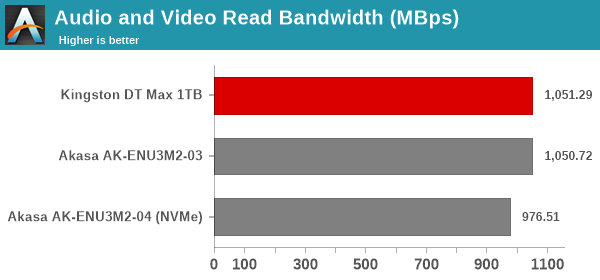
The workloads are processed in sequence, and the initial ones - particularly the read workloads - show great performance from the DT Max. However, with more and more traffic, as the workloads shift to the 'disk-to-disk' sections, the SLC cache runs out. Performance numbers are equivalent to what one might expect from bus-powered portable hard drives.
As long as the workload is contained within the SLC cache (more on the sizing further down in this section), it can be seen that there is no significant gulf in the numbers between the different units. For all practical purposes, casual users will not notice the difference between them in the course of normal usage. However, power users may want to dig deeper to understand the limits of each device. To address this concern, we also instrumented our evaluation scheme for determining performance consistency.
Performance Consistency
Aspects influencing the performance consistency include SLC caching and thermal throttling / firmware caps on access rates to avoid overheating. This is important for power users, as the last thing that they want to see when copying over 100s of GB of data is the transfer rate going down to USB 2.0 speeds.
In addition to tracking the instantaneous read and write speeds of the DAS when processing the AnandTech DAS Suite, the temperature of the drive was also recorded. In earlier reviews, we used to track the temperature all through. However, we have observed that SMART read-outs for the temperature in NVMe SSDs using USB 3.2 Gen 2 bridge chips end up negatively affecting the actual transfer rates. To avoid this problem, we have restricted ourselves to recording the temperature only during the idling intervals. The graphs below present the recorded data.
| AnandTech DAS Suite - Performance Consistency | |
| TOP: | BOTTOM: |
 |
|
 |
|
The first three sets of writes and reads correspond to the AV suite. A small gap (for the transfer of the video suite from the internal SSD to the RAM drive) is followed by three sets for the Home suite. Another small RAM-drive transfer gap is followed by three sets for the Blu-ray folder. This is followed up with the large-sized ISO files set. Finally, we have the single disk-to-disk transfer set. It appears that either enough SLC cache is available or it is recovered fast enough to cover almost 11 transfer sets. Once the cache is out, the performance goes down from close to 1GBps to around 80 MBps.
PCMark 10 Storage Bench - Real-World Access Traces
There are a number of storage benchmarks that can subject a device to artificial access traces by varying the mix of reads and writes, the access block sizes, and the queue depth / number of outstanding data requests. We saw results from two popular ones - ATTO, and CrystalDiskMark - in a previous section. More serious benchmarks, however, actually replicate access traces from real-world workloads to determine the suitability of a particular device for a particular workload. Real-world access traces may be used for simulating the behavior of computing activities that are limited by storage performance. Examples include booting an operating system or loading a particular game from the disk.
PCMark 10's storage bench (introduced in v2.1.2153) includes four storage benchmarks that use relevant real-world traces from popular applications and common tasks to fully test the performance of the latest modern drives:
- The Full System Drive Benchmark uses a wide-ranging set of real-world traces from popular applications and common tasks to fully test the performance of the fastest modern drives. It involves a total of 204 GB of write traffic.
- The Quick System Drive Benchmark is a shorter test with a smaller set of less demanding real-world traces. It subjects the device to 23 GB of writes.
- The Data Drive Benchmark is designed to test drives that are used for storing files rather than applications. These typically include NAS drives, USB sticks, memory cards, and other external storage devices. The device is subjected to 15 GB of writes.
- The Drive Performance Consistency Test is a long-running and extremely demanding test with a heavy, continuous load for expert users. In-depth reporting shows how the performance of the drive varies under different conditions. This writes more than 23 TB of data to the drive.
Despite the data drive benchmark appearing most suitable for testing direct-attached storage, we opt to run the full system drive benchmark as part of our evaluation flow. Many of us use portable flash drives as boot drives and storage for Steam games. These types of use-cases are addressed only in the full system drive benchmark.
The Full System Drive Benchmark comprises of 23 different traces. For the purpose of presenting results, we classify them under five different categories:
- Boot: Replay of storage access trace recorded while booting Windows 10
- Creative: Replay of storage access traces recorded during the start up and usage of Adobe applications such as Acrobat, After Effects, Illustrator, Premiere Pro, Lightroom, and Photoshop.
- Office: Replay of storage access traces recorded during the usage of Microsoft Office applications such as Excel and Powerpoint.
- Gaming: Replay of storage access traces recorded during the start up of games such as Battlefield V, Call of Duty Black Ops 4, and Overwatch.
- File Transfers: Replay of storage access traces (Write-Only, Read-Write, and Read-Only) recorded during the transfer of data such as ISOs and photographs.
PCMark 10 also generates an overall score, bandwidth, and average latency number for quick comparison of different drives. The sub-sections in the rest of the page reference the access traces specified in the PCMark 10 Technical Guide.
Booting Windows 10
The read-write bandwidth recorded for each drive in the boo access trace is presented below.
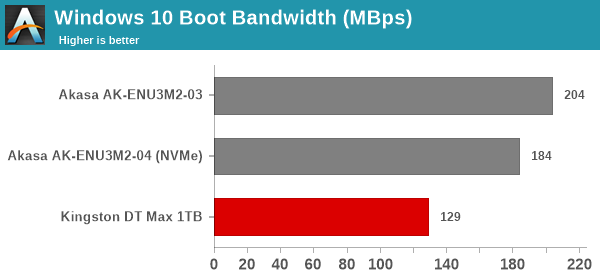
Performance numbers are roughly in line with what can be expected from a 1TB PCIe 3.0 x2 NVMe drive behind a USB 3.2 Gen 2 bridge. Since our comparison drives both use PCIe 3.0 x4 SSDs, there is a significant gulf in performance.
Creative Workloads
The read-write bandwidth recorded for each drive in the sacr, saft, sill, spre, slig, sps, aft, exc, ill, ind, psh, and psl access traces are presented below.
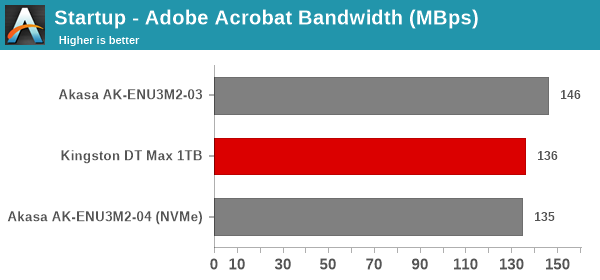
Surprisingly, despite the usage of a PCIe 3.0 x4 NVMe drive inside the Akasa enclosures, the Kingston DT Max manages to come in the middle of the pack in most workloads.
Office Workloads
The read-write bandwidth recorded for each drive in the exc and pow access traces are presented below.

The DT Max performs very similar to other drives for the Excel and Powerpoint storage traces.
Gaming Workloads
The read-write bandwidth recorded for each drive in the bf, cod, and ow access traces are presented below.
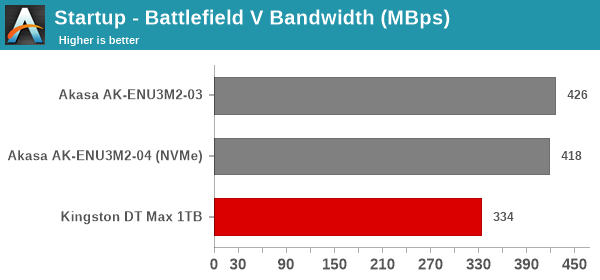
Certain games such as Call of Duty perform very well in this read-intensive benchmark. However, for load times, the bridge solutions work out better for most cases.
Files Transfer Workloads
The read-write bandwidth recorded for each drive in the cp1, cp2, cp3, cps1, cps2, and cps3 access traces are presented below.
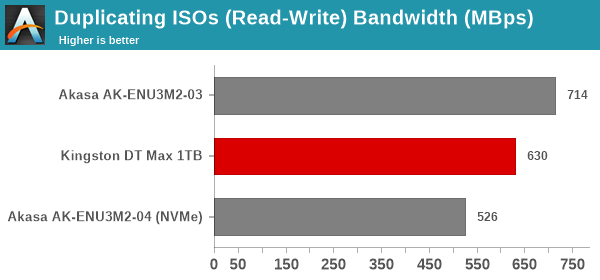
The PCIe 3.0 x4 NVMe SSDs in the Akasa enclosure deliver better performance for these stressful sequential workloads, with the Kingston DT Max consistently falling in the lower half.
Overall Scores
PCMark 10 reports an overall score based on the observed bandwidth and access times for the full workload set. The score, bandwidth, and average access latency for each of the drives are presented below.
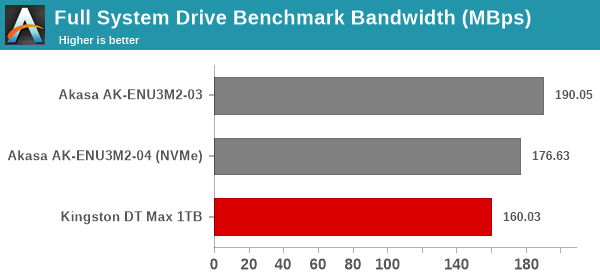
Given the analysis of the aforementioned results, it is clear that a bridge solution delivers a better experience in most cases. However, the Kingston DT Max delivers respectable numbers equivalent to that of a DRAM-less PCIe 3.0 x2 NVMe SSD behind a USB 3.2 Gen 2 bridge.










12 Comments
View All Comments
cyrusfox - Thursday, September 30, 2021 - link
Nice performance! Too bad about the price premium for the form factor[$180], hard to compete with other flash drives, definitely the performance crown at the smallest size, but easier to get a cheap m.2 enclosure and deal with the extra bulk and equivalent to superior performance, what else to do with the spare m.2 chucked from laptops...eastcoast_pete - Thursday, September 30, 2021 - link
The absence of any "thermal solution" is disappointing for that device and price class. A small strip of a quality thermal pad (FujiPoly or comparable) and it would likely not get that dangerously hot (hot enough to cause mild burns). Well fitted thermal pads, and a body made from cast aluminum (as heat sink), and it'd probably be all set, at least temperature-wise.Actually, what is that case made of? Did I overlook that in the article?
ganeshts - Thursday, September 30, 2021 - link
Casing is fully plastic. In one sense, this may be user-friendly - the exterior doesn't get hot enough to touch (something that is bound to happen a lot for a thumb drive). But, as suggested, the internal board deserves a thermal pad at the least.eastcoast_pete - Thursday, September 30, 2021 - link
Thanks for the update! Given the price point of that drive, another dollar or two in the BOM for an anodized aluminum body (as heatsink) and a few square centimeters of thermal pads would have been a great investment that would have helped sales.Tams80 - Friday, October 1, 2021 - link
It's also supposed to be practically portable though, and plastic is far less likely to cause damage to other items in bags/on key chains and won't look too bad acter some abuse. Aluminium on the other hand is terrible for that and will end up looking a mess.meacupla - Sunday, October 3, 2021 - link
A properly designed partial aluminum enclosure won't damage other things in your bag.Also, if your, be it partial or fully, aluminum enclosure is getting significantly messed up, maybe don't throw it in a bag that also contains your keys.
meacupla - Thursday, September 30, 2021 - link
I half expect someone to make this drive go even faster by adding some thermal pads and a chunky heatsink.I would guess the controller has thermal protection and throttles when it gets hot.
Wereweeb - Friday, October 1, 2021 - link
>Can't transfer more than 90GB of data per time, otherwise falls to QLC speeds>Half the random speeds of NVMe-through-USB
Ok, I get it, first-gen, too compact
>Couldn't find a way to cool down the controller while still making it skin-friendly (Aluminium body with fins, thermal pads, maybe some silicone on the edges for more comfort in handling?)
>$160 for 1TB NAND on a simple PCB in an injection-molded plastic shell.
Is it just me or does this look like a somewhat weird first-gen-y product that doesn't seem to know if it wants to directly compete with NVMe SSD's on performance?
Up2Trix - Sunday, October 3, 2021 - link
Ganesh, thanks much for this review. I am very much in the market for a flash drive of this type. I have been waiting for powerful USB controllers for, I dunno, 6+ years now...I currently own a Corsair Flash Voyager GTX. It uses a SATA SSD controller (crappy low end one?) behind a USB <--> SATA bridge chip. It was about the best flash drive available until this Kingston, but Corsair has stubbornly refused to update it since it was released 3 or 4 years ago.
I would love to upgrade from the Corsair, but nobody was releasing anything compellingly better. This Kingston is a leap forward.
I am with eastcoast_pete: my main dislike of this Kingston is the absence of any "thermal solution", and I too would like its body to be aluminum (even if it scratches).
I too would also love if it had a dual-connector (Type-C + Type-A).
Corsair: I hope that you are reading this!
PleaseNoMoreVideoAds - Sunday, October 3, 2021 - link
I just made an account to say: PLEASE DO SOMETHING ABOUT THE AUTOPLAYING VIDEO ADS WITH AUDIO.The site is becoming unusable.
Thanks and best wishes.